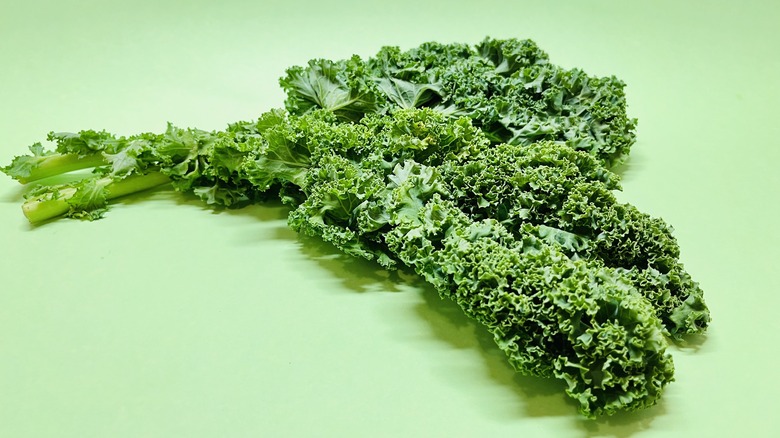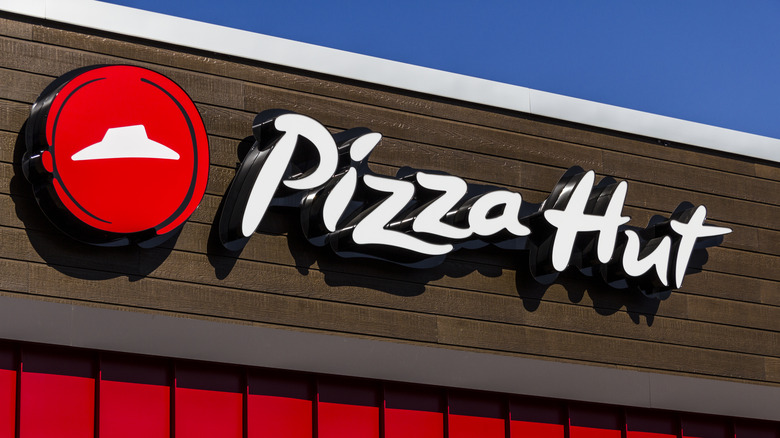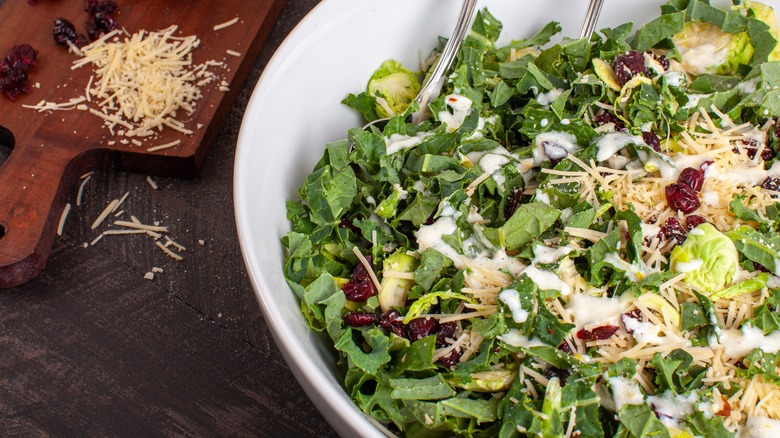The Wasteful Reason Pizza Hut Used To Be A Top Kale Buyer
It seems unimaginable, but there was a time when kale wasn't a staple of grocery shelves and trendy restaurants. Americans of previous generations could go their entire lives without encountering kale smoothies, kale Caesars, kale pesto, kale chips, or kale-topped protein bowls. That's not to say that they weren't coming into regular contact with the cruciferous vegetable. They just weren't buying it — and they weren't eating it. Instead, they were appreciating its aesthetic qualities.
Specifically, they were appreciating its aesthetic qualities at their local Pizza Hut outlet, where kale had one job and one job only: It was there to decorate the salad bar, arrayed exuberantly around bowls of iceberg lettuce, shredded cheese, croutons, and ranch dressing. Wasteful? Absolutely — it's not like you could get it as a pizza topping. But the fact remains that Pizza Hut was one of the top kale buyers in the country, purchasing almost 14,000 pounds of the stuff as late as 2012. That seems to have been the year everything started changing and kale began to ascend to its role as green-vegetable royalty, an item that diners and grocery shoppers would seek out on its own merits; agricultural acreage devoted to growing kale climbed 145% between 2012 and 2017. Now, of course, it's ubiquitous — just not at Pizza Hut anymore.
Why Pizza Hut bought so much kale
At Pizza Hut, to be clear, the kale had a functional role to play in an era before the restaurant used artificial refrigeration to keep the salad bar cold: Kale concealed the piles of ice surrounding all of those salad fixings. While Pizza Hut hasn't said specifically what kind of kale it used, it's possible to purchase ornamental varieties of kale and other brassicas like cabbage — cultivars that are especially colorful and showy. While technically edible, ornamental brassicas are a bit on the bitter side and can turn an off-putting gray color when cooked.
That we're eating kale today, rather than simply looking at it, is good news indeed. America has a problem with food waste, with up to 38% of all food in this country — about 92 billion pounds annually — ending up in the trash. 14,000 pounds of kale going to the landfill surely didn't help this problem. And then there's the fact that kale is a superfood, packed with nutrients and, as many American eaters have learned, quite tasty — though it's a good idea to buy organic kale, since the conventional kind has tested high in residual pesticides, per the Environmental Working Group.
How Americans developed a taste for kale
Some food trends grow from the ground up, but the kale enjoyed the additional benefit of having a well-connected and energetic advocate: Oberon Sinclair, who runs a New York-based PR firm and embarked on a campaign in the 2010s to make kale famous. She enlisted celebs to promote it and got it on the menu of influential Manhattan restaurants. Kale had already been gaining popularity, but Sinclair helped raise its profile even further. Now kale is part of the ever-growing cornucopia of greens to buy at the grocery store. You can still find it at chain restaurants too — only playing a more dignified role as the star of salads at trendy fast-casual businesses like Sweetgreen.
Another chain restaurant may have had a role to play, if inadvertent, in kale's ascendance: Chick-fil-A. After a Vermont vegetable farmer had shirts printed that read "Eat More Kale," he found himself on the receiving end of a 2011 lawsuit from the Georgia-based chicken sandwich company — which alleged that the phrase too closely resembled Chick-fil-A's own "Eat Mor Chikin" motto. The corporate giant may have ended up just drawing more attention to the apparel in question; after the printer of the shirt stood his ground, he ended up selling more than a million dollars worth of shirts. Now Chick-fil-A serves a kale salad on its menu. The lesson? If you can't beat 'em, eat 'em.


